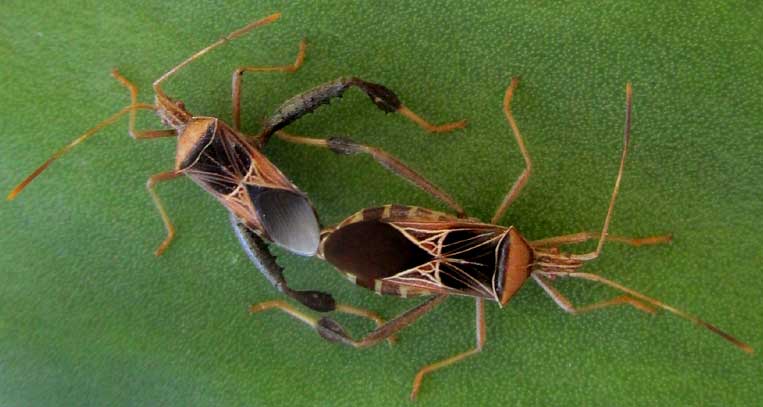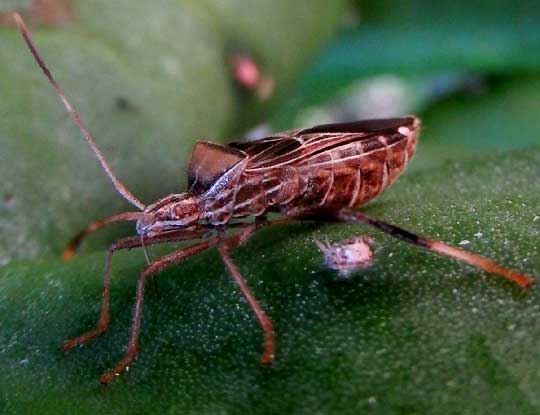Excerpts from Jim Conrad's
Naturalist Newsletter

from the November 15, 2015 Newsletter issued from Hacienda Chichen Resort beside Chichén Itzá Ruins,
central Yucatán, MÉXICO
CACTUS BUG
About four years ago I planted a pad of Nopal Cactus -- a spineless, edible species much
cherished by Mexican country folk who eat its pads and fruits -- in front of the hut. Now
the cactus consists of many pads and stands higher than my head. One morning this week I
noticed some bugs on it apparently making themselves at home, which included feeding on
the cactus and procreating on it, as shown above.
A close-up showing a prettily stripe-faced one with his slender, strawlike proboscis inserted into a pad is shown below:

In calling this species a bug I'm using the term "bug" advisedly, because these critters are members of the insect order Hemiptera, known as "true bugs." Technically, ladybird beetles aren't bugs, because they're beetles. But these bugs on my Nopal, with their distinctive sucking mouthparts and four wings, with the front wings thickened at their bases, are classic bugs, technically correct bugs, in fact "true bugs." As a kid on the Kentucky farm, the best-known true bugs were "stinkbugs," whose shapes were very similar to these, and who stank defensively if poked at too roughly.
But these cactus-living bugs outside my hut door aren't stinkers. Still, the world of True Bugs is so enormous and diverse that just about any kind of behavior can be expected of one or another of its species, not just stinkiness.
I was especially interested in these bugs' identity because during my recent stay in Río Lagartos the tops of fenceposts throughout the surrounding country often were affixed with yellow, harmonica-size items the shapes of prisms, their ends open and their interior walls coated with flypaper-stickiness, and pheromones. The pheromones attracted a certain kind of insect whose hungry larvae threaten to destroy many of Mexico's Nopal Cactus plantations. We don't have big Nopal plantations in the Yucatan, but in the dry uplands of central and northern Mexico they do. The pheromone traps were monitored regularly to watch for the destructive bug's appearance here. Therefore, could these bugs on the cactus outside my hut possibly be one of them? The pictures were sent off to volunteer identifier Bea in Ontario, who with her usual expertise quickly replied that they were LEPTOGLOSSUS SUBAURATUS.
It turns out that Leptoglossus is a diverse and complex genus, with 61 species recognized in the Americas. Since true bugs sometimes are of importance to agriculture, they're better studied than some other orders, and it was possible to download Harry Brailovsky's 2014 work in the journal Zootaxa, the title of which begins -- in case you want to Google it -- "Illustrated key for identification of the species included in the genus Leptoglossus... "
The Internet is peppered with lists showing that Leptoglossus subauratus has been collected here and there in places from southern Mexico to Costa Rica, and a few notes detail such matters as the species' tibia length and the color of its pronotal disk, but there's hardly any information out there describing the bug's behavior, except for one note that a collection was made on a cactus. Apparently Leptoglossus subauratus isn't the bug decimating some of Mexico's cactus plantations, else surely it would be mentioned somewhere.
So maybe our entry here will help a graduate student someday by letting them know that here in the Yucatan in mid November, Leptoglossus subauratus can be found feeding and mating on Nopal Cactus, Opuntia ficus-indica.